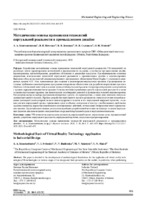| dc.contributor.author | Константинова, А. А. | |
| dc.contributor.author | Ивченко, В. И. | |
| dc.contributor.author | Бохонко, В. В. | |
| dc.contributor.author | Соловьев, Н. В. | |
| dc.contributor.author | Мойсей, O. Н. | |
| dc.coverage.spatial | Минск | ru |
| dc.date.accessioned | 2021-12-02T12:55:39Z | |
| dc.date.available | 2021-12-02T12:55:39Z | |
| dc.date.issued | 2021 | |
| dc.identifier.citation | Методические основы применения технологий виртуальной реальности в промышленном дизайне = Methodological Basis of Virtual Reality Technology Application in Industrial Design / А. А. Константинова [и др.] // Наука и техника. – 2021. – № 6. – С. 465-475. | ru |
| dc.identifier.uri | https://rep.bntu.by/handle/data/107577 | |
| dc.description.abstract | Разработаны методические основы применения технологий виртуальной реальности (VR-технологий) на различных этапах проектирования автомобилей и продвижения их на рынке, в частности при выполнении дизайн-проектирования, прототипирования, разработке обучающих и рекламных продуктов. Проанализированы основные направления использования технологий виртуальной реальности в промышленном дизайне в машиностроении. Выполнен обзор возможностей специализированного программного обеспечения Unreal Engine 4 и комплекта аппаратных средств HTC Vive, применяемых для создания и демонстрации виртуальных проектов. Сформированы системные требования к компьютерному программно-аппаратному обеспечению для разработки виртуальных проектов. Обобщен собственный опыт использования технологий виртуальной реальности при проектировании электромобиля с кузовом каркасно-панельной конструкции. Описана методика применения средств виртуальной реальности в целях создания виртуальных проектов для демонстрации дизайнерских решений и функционала изделий машиностроения. Рассмотрены вопросы выбора программно-аппаратных средств, их характеристик, а также дано описание этапов создания виртуального проекта. Процесс разработки виртуального проекта разделен на этапы подготовки и преобразования трехмерной компьютерной модели демонстрируемого изделия в его виртуальный цифровой прототип, создания для него виртуальной среды с присвоением среде и объекту материалов и текстур с необходимыми свойствами, задания освещения, параметров навигации и анимированных действий, оптимизации отображения теней и финализации проекта. Представлены основные результаты апробации разработанной методики на примере создания виртуальных проектов для демонстрации электромобиля в городской виртуальной среде и виртуальном павильоне. | ru |
| dc.language.iso | ru | ru |
| dc.publisher | БНТУ | ru |
| dc.title | Методические основы применения технологий виртуальной реальности в промышленном дизайне | ru |
| dc.title.alternative | Methodological Basis of Virtual Reality Technology Application in Industrial Design | ru |
| dc.type | Article | ru |
| dc.identifier.doi | 10.21122/2227-1031-2021-20-6-465-475 | |
| local.description.annotation | design, prototyping, development of educational and advertising products. The paper analyzes the main areas of application of virtual reality technologies in industrial design in mechanical engineering. An overview of the parameters of the specialized software Unreal Engine 4 and the HTC Vive hardware set used to create and demonstrate virtual projects is performed. System requirements for computer software and hardware for creating virtual projects have been formed. A generalization of our own experience of using virtual reality technologies in the design of an electric vehicle with a frame-panel structure is carried out. The technique of using virtual reality tools in order to create virtual projects for demonstration of design solutions and functionality of mechanical engineering products is described. The issues of choosing software and hardware, their characteristics are considered, as well as a description of the stages of creating a virtual project is given. The process of developing a virtual project is divided into the stages of preparing and transforming a three-dimensional computer model of the demonstrated product into its virtual digital prototype, creating a virtual environment for it, assigning materials and textures with the necessary properties to the environment and the object, setting lighting, navigation parameters and animated actions, optimizing the display of shadows and finalizing the project. The main results of approbation of the developed methodology are presented on the example of creating virtual projects for demonstrating an electric vehicle: in an urban virtual environment and in a virtual pavilion. | ru |

